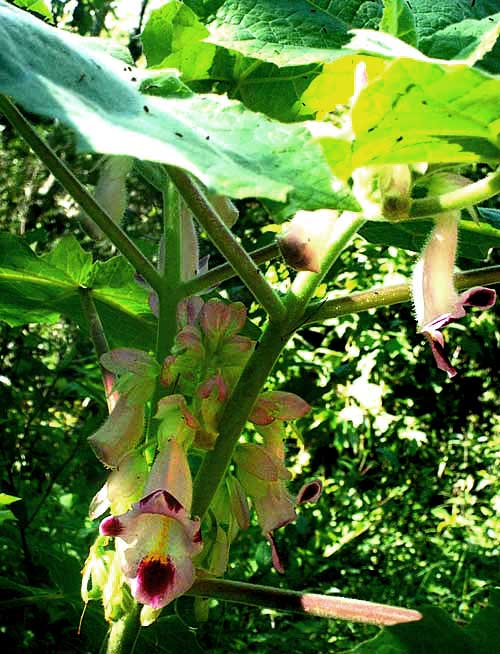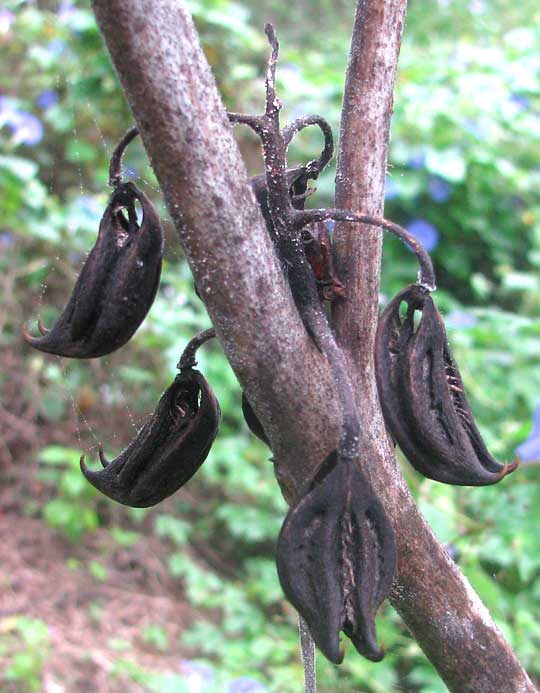Excerpts from Jim Conrad's
Naturalist Newsletter
from the September 14, 2007 Newsletter issued from Sierra Gorda Biosphere Reserve, QUERÉTARO, MÉXICO
DEVIL'S CLAWS FROM PRETTY FLOWERS
Along weedy roadsides nowadays there's a knee-high herb graced with strikingly pretty clusters of drooping, 1.5-inch-long blossoms, which you can see below:

Notice how each flower's corolla is provided with a large lower lip where pollinating insects such as bees can land, then follow yellow nectar guides to where the nectar is. The entire plant, including the flowers, is invested with gland-topped hairs, giving the parts a velvety, sticky feeling. In the picture you can see debris and tiny insects adhering to all parts. This is an unusual plant, and assigning it to its family makes a good exercise.
One reason for that is that the species is MARTYNIA ANNUA, a member of the Martynia Family, the Martyniaceae, which isn't a well-known family. Often plants in the family are called "Devil's Claws" because of the 2-hooked form of their seed pods. The fruits are well adapted for dispersal by large mammals, maybe even mammals long extinct.
Martynia annua is native to Mexico and Central America but its excellent dispersal mechanism has helped it spread throughout the tropical world as a weed. I read that "In novelty shops of Mexico the pods of Martynia annua are hooked around a central disk to form a clever decorative sunflower."
In India the plant has been known long enough for it to constitute part of the traditional pharmacopia. Its leaf juice is gargled for sore throats, oil from its fruits and seeds is smeared onto scabies infections, a paste of the seeds and fruits is thought to be effective for bites of venomous insects and scorpions, and more.
from the December 6, 2009 Newsletter issued from Hacienda Chichen Resort beside Chichén Itzá Ruins, central Yucatán, MÉXICO
DEVIL'S CLAWS
Here and there nowadays you run into head-high, dead herbs bearing the very hard, sharp-clawed fruits seen below:

In Querétaro we called them Devil's Claws but here they're known as Uña de Gatos, or Cat-Claws. They're MARTYNIA ANNUA, plants so unusual that usually they're placed in their own family, the Martynia Family, the Martyniaceae.
The fruits, which technically are capsules, are harder than most woods and the curved claws are very sharp, easily able to mangle a bare foot that steps on them. Best I can tell, each fruit contains four seeds, two in each fruit half. When I macheted across one -- with difficulty because they were so hard -- the endosperm, or seed "meat," was oily and white like that of coconut. I suspect that some cultures hold these fruits in special regard because they look like the upper jaw and fangs of a pit viper.
I read that before the fruits harden and are still green they resemble bean pods or okra, and are cooked and eaten as a vegetable by indigenous North American people. The dried seeds are rich in protein and can be shelled and eaten. The seeds are so oily that sometimes they've been used to polish pottery. A report from Chihuahua says that the Tarahumara there prepare a tea from the fruits, which they take to relieve headaches.
When my friend Cresencio saw the fruit picture above he told me that when the plant is fresh his people collect the leaves, which are covered with sticky glands, place them beneath their hammocks, and then when fleas come they get stuck to the leaves and don't jump up into the hammock!